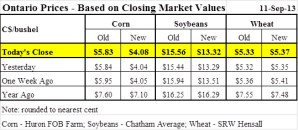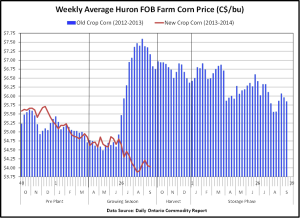For the very first time, the 2016 Census of Agriculture asked, “did this operation sell any agricultural products directly to consumers for human consumption?” With this simple question, we now have a glimpse into direct sales of Ontario’s local foods that we’ve never had before!
Ontario leads the country with 7,474 farms reporting direct-to-consumer sales, followed by British Columbia and Quebec with 5,667 and 5,459 farms respectively. Overall, 15.1% of Ontario’s farms are making local foods available for direct purchase by consumers.
At the regional-level, fascinating patterns emerge in the prevalence of direct-to-consumer farm sales. Click to see maps by the number and percentage of farms reporting direct sales. Ontario’s Central West Region is a direct marketing powerhouse with over 330 farms engaging in direct-to-consumer sales in each of Grey, Wellington, Niagara, Simcoe, and Waterloo. It is also notable to look at regions with the highest proportion of farms engaging in direct-to-consumer sales. By this metric, Haliburton leads the province with 53% of farms engaging in some form of direct sales, followed by Muskoka with 48%. In Thunder Bay, Algoma, Parry Sound, and Kenora, roughly 40% of all farms are engaging in direct-to-consumer sales – an indication of the importance of direct marketing as a sales channel for Northern Ontario producers.

| Top 5 Regions for Number of Farms Selling Value-Added Products Direct-to-Consumer | ||
| County/Region | # of farms | |
| 1 | Niagara | 54 |
| 2 | Simcoe | 45 |
| 3 | Grey | 41 |
| 4 | Durham | 36 |
| 5 | Prince Edward | 32 |
What is being sold?
Nearly all of Ontario’s direct marketers (97% or 7,265 farms) are selling unprocessed agricultural products, while only 12% or 907 farms are selling value-added products. This represents a potential area for growth as Ontario is lagging behind Quebec, most Maritime Provinces and the national average of 14%. Niagara Region has the highest number of farms reporting direct sales of value-added products at 54.
How is it being sold?
The predominant sales channel for Ontario’s direct marketers is on-farm retail (farm gate/stand/kiosk/u-pick) with 90% (6,709 farms) using this channel. Farmers’ markets are the second most common channel: 1,619 farms sell their products at one or more farmers’ markets. This represents 3.3% of all Ontario farms, just above the national average of 2.8%. In Ontario, Niagara Region has the most farms reporting farmers’ market sales (122 farms) while Kenora, Thunder Bay and Algoma have the highest proportion of farms reporting farmers’ markets sales.
| Top 5 Regions for Number of Farms Selling through Farmers’ Markets | ||
| County/Region | # of farms | |
| 1 | Niagara | 122 |
| 2 | Simcoe | 85 |
| 3 | Haldimand-Norfolk | 72 |
| 4 | Wellington | 67 |
| 5 | Grey | 65 |
Across Ontario, 403 farms report selling through Community-Support Agriculture or CSA. These farms are fairly evenly dispersed throughout the province; every county/region has at least one farm reporting CSA sales, with the exception of Rainy River. Grey, Durham, and Wellington have the highest number of CSAs at 19 farms each.
Of the 24,510 Canadian farms reporting direct-to-consumer sales, 30% call Ontario home! This Local Food Week, let’s celebrate the value of our direct farm marketing sector, not only for the economic opportunities it creates, but also for the access to local food it affords, the community it fosters, and the agriculture and food literacy it builds.
Note: all data for this blog was sourced from CANSIM Table 004-0244 Census of Agriculture, farms reporting selling agricultural products directly to consumers in the year prior to the census.

